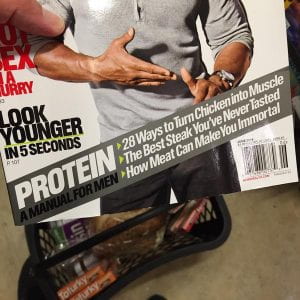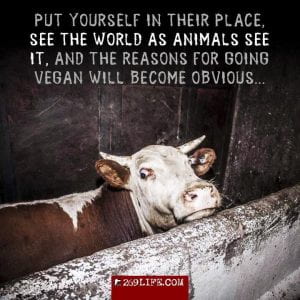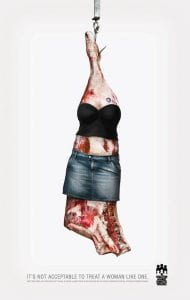The images I chose implicitly as well as explicitly discriminates women and animals. Thereby sexualizing women as objects and associating them with animals, dehumanizes them at the expense of dead animals. This is exactly what women have been running from most of their lives and, why feminist movements have been trying to bring change. So the negative images and behavior is exactly what the “Me Too Movement” entails. Talshir, an Israel news writer, makes light of the abuse of women in connection to that of animals:
“The unique aspect of the #metoo movement is the personal way in which each woman can attest to the sexual violence she experienced. This is the essential difference between the feminist struggle and the fight for animal rights – as women, we fight for ourselves. But in our struggle for animal rights, our testimony to the violence they experience will always be second-hand, testimony as observers” (Talshir, Haaretz.com).
In the first image, what is seen as a chicken on plates, looks like it’s being prepared to be eaten. It is a portrayal of what is said to be “food”, as well as a helpless woman in “bondage”. The faceless chicken is tied from the waist down to long, lean legs and thighs, the string is then wrapped around the hips down to the buttocks.
Similar to the chicken, the second image is also faceless and looks like either part of a butchered cow or pig. It is scantily dressed sexy, wearing a corset that shows cleavage, a stamp that could be seen as a tattoo on the breast, and low-rise jeans mini skirt. In our society both images are seen as food however, the darker side to them are much more obvious, especially because they are sexually suggestive. The story these images convey is that women as well as animals are no more than an object – that being a piece of meat. As we’ve learned, images like these depicts enslavement as well as domination of women in a patriarchal world, mainly due to the sexually provocative nature of the images. We’ve also learned misogyny and speciesism is tied to the consumption of meat by men. Additionally, manipulating women and animals is seen as the norm in our society, making us desensitized by the images.
The third image shows a person with a shopping basket that has all plant-based protein items, looking at a men’s magazine. The magazine cover shows off a muscular man, as well as wording on how a man would look if he eats  protein in the form of meat. It describees “28 ways to turn chicken into muscle”, “the best steak you’ve never tasted”, and “how meat can make you immortal”. Conversely, this image objectifies meat by stating that “real men” eat “real meat” not fake meat like the “tofurky bars” (in the shopping basket)
protein in the form of meat. It describees “28 ways to turn chicken into muscle”, “the best steak you’ve never tasted”, and “how meat can make you immortal”. Conversely, this image objectifies meat by stating that “real men” eat “real meat” not fake meat like the “tofurky bars” (in the shopping basket)
By standing back to look at the picture, it becomes clear that we will implode by our own disdain for life itself. The condition of the cow and the fear in the eyes says it all; she (or he) sees death coming. Adams “False Mass Terms” describes “the most efficient way to insure that humans do not care about the lives of animals is to transform non-human subjects into non-human objects” (Adams, 6). In other word, when an animal has been turned into meat it becomes food, so we no longer associate it with “being” or an animal for that matter but as a “product. Better yet, we do not see our meat as animals because we choose not to; when we see it that way we will realize that we are eating something we shouldn’t be eating. But why don’t we realize we are wrong anyway right? Adams explains, the “False Mass term as short-hand – “Because they are not like us” (Adams, 6). By definition, they don’t look like us, behave like us and, they do not have feelings. In her article, she also related this this to racism, pointing out that racism as well as the way immigrants issues are handled, are both seen in under the same lens. Looking in an animal’s eyes (particularly this one), should awaken “compassion” in us. It should make us question ourselves and the decisions we make to turn animals into food – like meat on our plate, and we have the nerve to call ourselves healthy. Per Adams, “to care that one have courage to break from the normalizing ideology screen, it’s ok if it’s an X but not a Y” (Adams, 10). In that, we become disconnected with the animal so we can “do what we gotta do” but in that process we also disconnect from ourselves.
by our own disdain for life itself. The condition of the cow and the fear in the eyes says it all; she (or he) sees death coming. Adams “False Mass Terms” describes “the most efficient way to insure that humans do not care about the lives of animals is to transform non-human subjects into non-human objects” (Adams, 6). In other word, when an animal has been turned into meat it becomes food, so we no longer associate it with “being” or an animal for that matter but as a “product. Better yet, we do not see our meat as animals because we choose not to; when we see it that way we will realize that we are eating something we shouldn’t be eating. But why don’t we realize we are wrong anyway right? Adams explains, the “False Mass term as short-hand – “Because they are not like us” (Adams, 6). By definition, they don’t look like us, behave like us and, they do not have feelings. In her article, she also related this this to racism, pointing out that racism as well as the way immigrants issues are handled, are both seen in under the same lens. Looking in an animal’s eyes (particularly this one), should awaken “compassion” in us. It should make us question ourselves and the decisions we make to turn animals into food – like meat on our plate, and we have the nerve to call ourselves healthy. Per Adams, “to care that one have courage to break from the normalizing ideology screen, it’s ok if it’s an X but not a Y” (Adams, 10). In that, we become disconnected with the animal so we can “do what we gotta do” but in that process we also disconnect from ourselves.
Sexualizing meat with images of women is one issue, killing animals turning them into food is another, however both are still being exploited. In this case, “it’s clear that parallels can be found, first of all, in exposing the injustices, on one hand sexual violence we have experienced, and on the other, the violence animals have experienced” (Talshir). In advocating for animals we are also advocating for ourselves. I mean, think about it, there are some thing that are just not meant to be eaten and for so many reasons – two most important, ethical as well as health. And as Adams puts it, “the question in animal advocacy has become muddled about whether the issue is the suffering or whether it is the death of the animal that matters” (Adams Interview, 14). For me, there are so many things morally wrong with these images and they are so hard to “unsee”. This and others like it over the past few weeks, is why I have not been able to meat and I’m not sure I can bring myself to do so in the future. It’s not that I’ve never heard about animal farms but learning about the abuse of animals has saddened me, hopefully “stared straight”.
Annotated Bibliography:
Talshir, Rachel. “When #MeToo Meets the Meat Industry: The Links Between Feminism and Animal Rights March 8, 2018,
https://www.haaretz.com/israel-news/culture/MAGAZINE-metoo-and-meat-the-links-between-feminism-and-animal-rights-1.5886654
Rachel Talshir is a reporter for Israel news. Her article was relevant to the topic of “Woman Nature Association” because it deals with women being objectified in by men just as animals. Talshir, interviews animal rights activist Shira Hertzano to have a better understanding of the similarities of the intersection.



I am glad to learn of your struggle with the continued eating of meat. I have the same struggle. I was essentially a vegetarian with the occasional lapse into bacon and salmon. I honestly agree with you on that front. I’m conjuring up my willpower to stop all meat consumption. No side dishes, no sushi runs, no hiding bacon under the table. These last few weeks, like yourself, have been profound on many levels.
The first profound change for me is the deep sadness in the depiction of animals as only a food substance. The ends justifies the means? Not for me, not anymore. The sheer horror nonhuman beings suffer at the hands of human beings is more than I can stand, and something I’ve known for a long, long time but refused to place in the forefront of my mind and action.
Secondly, it always greatly disturbed my consciousness that advertising literally debased, objectified, sexualized and disregarded women in the making of media campaigns for the sake of generating revenue for their clientele. How did we arrive here? Is it a backlash of feminism? Did it begin when women came out en-masse in protest of their lesser status in society? Growing up, I don’t recall ads like these but were they always present? https://en.wikipedia.org/wiki/Gender_advertisement states that since the 1920s, advertising have placed women into a particular, domestic, sexual role. And it’s only gotten worse.
Thirdly, the idea that nonhuman beings are cut up, dismembered, tied, tattooed, scantily clad, sexualized beyond all recognition of what they once were, is so harmful to all of us in the continuing desensitization of humanity. Do I want to be compared to a dismembered side of beef, hung upside down and dressed “like a whore”? This is a blantant depiction of speciesism, sexism, racism, pornography, violence and murder on a scale of nearly insurmountable proportion. I am so angry and confused by the choices of what appropriate advertising is! If women were in charge of these media campaigns, would they be the same?
https://www.theguardian.com/media/2019/apr/14/sexism-in-advertising-industry-gender-pay-gap-diversity is an article looking at gender discrimination, huge pay gaps and the old boy network. Until this changes, women and nonhuman creatures will pay the price, in full, for apocalyptic patriarchal hatred of all beings other than men.
Great analyses of the advertisements. The major theme of every advertisement is that the animals in the photos are no living beings – they are just meat. They are objects. The quote you included from Adams about how “the most efficient way to insure that humans do not care about the lives of animals is to transform non-human subjects into non-human objects” puts it perfectly. This is how we like to view animals in advertisements, and it is also how we like to view animals when we are eating them. Meat eaters do not want to know the process of how the animal gets to the grocery store / the table, they just want to see them there. In our American culture, we are taught to think that certain animal parts are good to eat and others are “gross.” In television shows like Fear Factor or The Challenge on MTV, they will have gross eating challenges. It always includes parts of animals that aren’t traditionally eaten in America, such as intestines or eyes. The characters will be shown gagging or crying about how disgusting the food it, but that’s only because we are trained to be that way. In other countries, it’s totally normal to eat organs. All of the parts of the animal that gross us out are ones that remind us it is a living creature (eyes, organs, blood, etc.).